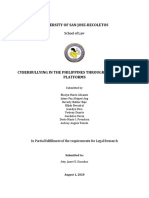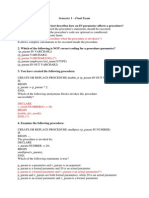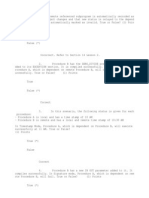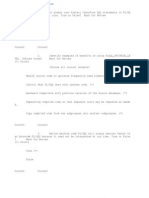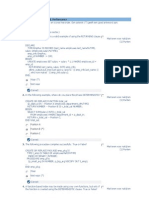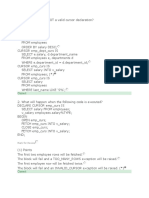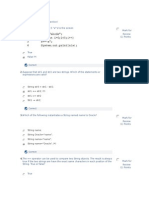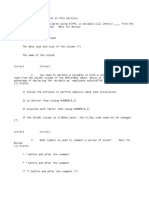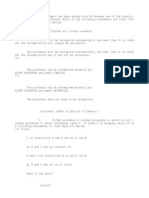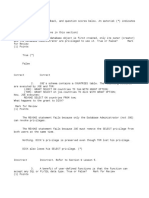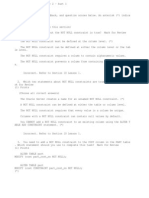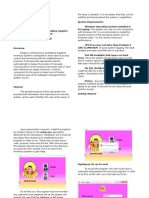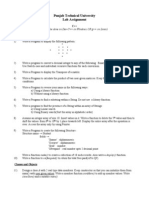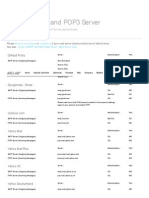Final
Final
Uploaded by
Mohanned AliCopyright:
Available Formats
Final
Final
Uploaded by
Mohanned AliCopyright
Available Formats
Share this document
Did you find this document useful?
Is this content inappropriate?
Copyright:
Available Formats
Final
Final
Uploaded by
Mohanned AliCopyright:
Available Formats
1 Test: Final Exam Semester 1 1. Why will this function not compile correctly?
CREATE FUNCTION bad_one IS BEGIN RETURN NULL; END bad_one; Mark for Review (1) Points You cannot RETURN a NULL. You must declare the type of the RETURN before the IS. (*) You must have at least one IN parameter. You must code CREATE OR REPLACE, not CREATE. The body of the function must contain at least one executable statement (as well as RETURN). Incorrect. Refer to Section 8. 2. Consider the following function: CREATE FUNCTION ADD_EM (a NUMBER := 1, b NUMBER := 2 ) RETURN NUMBER IS BEGIN RETURN (a+b); END ADD_EM; Which one of the following blocks will NOT work correctly? Mark for Review (1) Points DECLARE x NUMBER; BEGIN x:= add_em(b=4); END; (*) DECLARE x NUMBER;
2 BEGIN x:= add_em(4); END; DECLARE x NUMBER; BEGIN x:= add_em(4,5); END; DECLARE x NUMBER; BEGIN x:= add_em; END; None of them will work. 3. A function named MYFUNC has been created. This function accepts one IN parameter of datatype VARCHAR2 and returns a NUMBER. You want to invoke the function within the following anonymous block: DECLARE v_var1 NUMBER(6,2); BEGIN -- Line A END; What could be coded at Liine A? Mark for Review (1) Points myfunc('Crocodile') := v_var1; myfunc(v_var1) := 'Crocodile'; myfunc(v_var1, 'Crocodile'); v_var1 := myfunc('Crocodile'); (*) myfunc('Crocodile', v_var1); Incorrect. Refer to Section 8.
3 4. You try to create a function named MYFUNC. The function does not compile correctly because there are errors in your code. Which Dictionary view can you query to see the errors? Mark for Review (1) Points USER_SOURCE USER_ERRORS (*) USER_OBJECTS USER_DEPENDENCIES USER_COMPILES Incorrect. Refer to Section 8. 5. What is wrong with the following code? CREATE FUNCTION badfunc (p_param NUMBER(4)) RETURN BOOLEAN IS BEGIN RETURN (p_param > 10); END badfunc; Mark for Review (1) Points P_PARAM must be declared AFTER the RETURN clause. P_PARAM must have a default value. The datatype of the IN parameter cannot have a precision or scale. It must be NUMBER, not NUMBER(4). (*) RETURN (p_param > 10); is wrong because you cannot return an expression. The NUMBER datatype must have a scale as well as a precision.
6. In a SELECT statement, where can a function NOT be used? Mark for Review (1) Points In a GROUP BY or HAVING clause. A function can be used anywhere in a SELECT statement. (*)
In a WHERE clause. In the column list (SELECT) clause. In an ORDER BY clause. 7. User REYHAN creates the following procedure: CREATE PROCEDURE proc1 AUTHID CURRENT_USER IS v_count NUMBER; BEGIN SELECT COUNT(*) INTO v_count FROM tom.employees; END; User BILL wants to execute this procedure. What privileges will BILL need? Mark for Review (1) Points EXECUTE on REYHAN.PROC1 and SELECT on TOM.EMPLOYEES (*) EXECUTE on REYHAN.PROC1 SELECT on TOM.EMPLOYEES BILL needs no privileges None of the above. The procedure will fail to compile because REYHAN does not have SELECT privilege on TOM.EMPLOYEES.
8. How do you specify that you want a procedure MYPROCA to use Invoker's Rights? Mark for Review (1) Points CREATE OR REPLACE PROCEDURE myproca AUTHID CURRENT_USER IS... (*) Invoker's Rights are the default, therefore no extra code is needed. GRANT INVOKER TO myprocA; ALTER PROCEDURE myproca TO INVOKER; CREATE OR REPLACE PROCEDURE myproca AUTHID OWNER IS... 9. You want to remove the procedure NO_NEED from your schema. You execute: DROP PROCEDURE no_need;
5 Which Data Dictionary views are updated automatically? Mark for Review (1) Points USER_PROCEDURES USER_OBJECTS USER_SOURCE All of the above. (*) None of the above. 10. Which Data Dictionary view can be used to display the detailed code of a procedure in your schema? Mark for Review (1) Points USER_PROCEDURES USER_OBJECTS USER_SOURCE (*) USER_SUBPROGRAMS None of the above. 11. You want to see the names, modes and data types of the formal parameters of function MY_FUNC in your schema. How can you do this? (Choose two) Mark for Review (1) Points (Choose all correct answers) Query USER_PARAMETERS Query USER_SOURCE (*) Query USER_FUNCTIONS SHOW PARAMETER my_funct; DESCRIBE my_funct; (*)
6 12. You have created a function named IS_LEAPYEAR that accepts one IN parameter of datatype DATE and returns a Boolean value (TRUE or FALSE) depending on whether the date is in a leap year. What is wrong with this query: SELECT last_name, hire_date FROM employees WHERE is_leapyear(hire_date)=TRUE; Mark for Review (1) Points The IS_LEAPYEAR function must be in the SELECT clause, not the WHERE clause. You cannot use DATE and BOOLEAN datatypes in the same function. The SELECT statement returns more than one row. IS_LEAPYEAR is a reserved word in the SQL language. The function returns a Boolean, and therefore cannot be used within a SELECT statement. (*)
13. Which one of the following statements about user-defined functions is NOT true? Mark for Review (1) Points They can execute spell-checking routines. They can be used inside SQL statements. They can be combined (nested) together, similar to nesting system functions, for example INITCAP(SUBSTR( .....)). They can return a TIMESTAMP datatype. They can allow you to COMMIT from inside a SELECT statement. (*)
14. Which of the following are NOT allowed in a function which is used inside a SQL statement which updates the EMPLOYEES table? (Choose two). Mark for Review (1) Points (Choose all correct answers) SELECT .... FROM departments ....;
7 COMMIT; (*) A RETURN statement. DDL statements such as CREATE or ALTER. (*) A WHEN OTHERS exception handler. Incorrect. Refer to Section 8. 15. Using nested blocks, when is it necessary to label the outer block?. Mark for Review (1) Points You must always label the outer block. You must always label both blocks. You must label the outer block when two variables with the same name are declared, one in each block. You must label the outer block when two variables with the same name are declared and you need to reference the outer block's variable within the inner block. (*) Block labels are just comments and are therefore recommended but never needed. 16. The following code does not violate any constraints and will not raise an ORA02292 error. What will happen when the code is executed? BEGIN DECLARE e_constraint_violation EXCEPTION; PRAGMA EXCEPTION_INIT(e_constraint_violation, -2292); BEGIN DBMS_OUTPUT.PUT_LINE('Inner block message'); END; EXCEPTION WHEN e_constraint_violation THEN DBMS_OUTPUT.PUT_LINE('Outer block message'); END; Mark for Review (1) Points Inner block message' will be displayed. The code will fail because the exception is declared in the inner block but is referenced in the outer block. (*)
Outer block message' will be displayed. The code will fail because line 4 should read: PRAGMA EXCEPTION_INIT(-2292, e_constraint_violation); Incorrect. Refer to Section 6. 17. What will happen when the following code is executed? DECLARE e_outer_excep EXCEPTION; BEGIN DECLARE e_inner_excep EXCEPTION; BEGIN RAISE e_outer_excep; END; EXCEPTION WHEN e_outer_excep THEN DBMS_OUTPUT.PUT_LINE('Outer raised'); WHEN e_inner_excep THEN DBMS_OUTPUT.PUT_LINE('Inner raised'); END; Mark for Review (1) Points The code will fail to compile because e_inner_excep cannot be referenced in the outer block. (*) The code will propagate the e_outer_excep back to the calling environment. The code will execute successfully and 'Outer Raised' will be displayed. The code will fail to compile because e_inner_excep was declared but never RAISEd. Incorrect. Refer to Section 6. 18. What will be displayed when the following code is executed? <<outer>> DECLARE v_myvar NUMBER; BEGIN v_myvar := 10; DECLARE v_myvar NUMBER := 200;
9 BEGIN outer.v_myvar := 20; v_myvar := v_myvar / 0; -- this raises a ZERO_DIVIDE error outer.v_myvar := 30; END; v_myvar := 40; EXCEPTION WHEN ZERO_DIVIDE THEN DBMS_OUTPUT.PUT_LINE(v_myvar); END; Mark for Review (1) Points 10 20 (*) 30 40 200 Incorrect. Refer to Section 6. 19. Examine the following code. What is the scope and visibility of the outer block's v_last_name? DECLARE v_last_name VARCHAR2(20); BEGIN DECLARE v_last_name VARCHAR2(20); BEGIN ... END: ... END; Mark for Review (1) Points It is in scope and visible in both blocks. It is in scope and visible in the outer block only. It is in scope in both blocks, but visible only in the outer block. (*)
10 It is visible in both blocks, but in scope only in the outer block. Incorrect. Refer to Section 6. 20. What will happen when the following code is executed? DECLARE e_excep1 EXCEPTION; e_excep2 EXCEPTION; BEGIN RAISE e_excep1; EXCEPTION WHEN e_excep1 THEN BEGIN RAISE e_excep2; END; END; Mark for Review (1) Points It will fail to compile because you cannot have a subblock inside an exception section. It will fail to compile because e_excep1 is out of scope in the subblock. It will fail to compile because you cannot declare more than one exception in the same block. It will compile successfully and return an unhandled e_excep2 to the calling environment. (*) Incorrect. Refer to Section 6.
21. You have created procedure MYPROC with a single parameter PARM1 NUMBER. Now you want to add a second parameter to the procedure. Which of the following will change the procedure successfully? Mark for Review (1) Points ALTER PROCEDURE myproc ADD (parm2 NUMBER); The procedure cannot be modified. Once a procedure has been created, the number of parameters cannot be changed. CREATE OR REPLACE PROCEDURE someproc (parm1 NUMBER, parm2 NUMBER); (You do not need to repeat the detailed code of the procedure, only the header)
11 REPLACE PROCEDURE someproc (parm1 NUMBER, parm2 NUMBER) IS BEGIN ... CREATE OR REPLACE PROCEDURE MYPROC (parm1 NUMBER, parm2 NUMBER) IS BEGIN ... (*) Incorrect. Refer to Section 7. 22. A procedure will execute faster if it has at least one parameter. Mark for Review (1) Points True False (*) Incorrect. Refer to Section 7. 23. You have created a procedure named MYPROC that accepts three IN parameters A, B, and C (all numbers). Which of the following calls to MYPROC is NOT correct? Mark for Review (1) Points myproc(5,10,20); myproc(a=>5,b=>10,20) (*) myproc(a=>5,b=>10,c=>20) myproc(5,10,c=>20) Incorrect. Refer to Section 7. 24. Which of the following best describes how an IN parameter affects a procedure? Mark for Review (1) Points It describes the order in which the procedure's statements should be executed. It describes which parts of the procedure's code are optional or conditional.
12 It makes the procedure execute faster. It passes a value into the procedure when the procedure is invoked. (*) It allows complex calculations to be executed inside the procedure. Incorrect. Refer to Section 7. 25. You want to create a procedure named SOMEPROC which accepts a single parameter named SOMEPARM. The parameter can be up to 100 characters long. Which of the following is correct syntax to do this? Mark for Review (1) Points CREATE PROCEDURE someproc (someparm varchar2) IS BEGIN ... (*) CREATE PROCEDURE someproc (someparm varchar2(100) ) IS BEGIN... CREATE PROCEDURE someproc IS (someparm VARCHAR2) BEGIN... CREATE PROCEDURE someproc someparm varchar2(100); IS BEGIN... CREATE PROCEDURE someproc (someparm 100) IS BEGIN ... 26. Which of the following is NOT correct coding for a procedure parameter? Mark for Review (1) Points (p_param IN VARCHAR2)
13
(p_param VARCHAR2) (p_param VARCHAR2(50)) (*) (p_param employees.last_name%TYPE) (p_param IN OUT VARCHAR2) Incorrect. Refer to Section 7. 27. An attempt to insert a null value into a NOT NULL table column raises an ORA01400 exception. How can you code an exception handler to trap this exception? Mark for Review (1) Points Test for WHEN ORA-1400 in the exception section. Declare a variable e_null_excep of type EXCEPTION, associate it with ORA-01400 using a PRAGMA directive, and test for WHEN e_null_excep in the exception section. (*) Declare a variable e_null_excep of type VARCHAR2, associate it with ORA-01400 using a PRAGMA directive, and test for WHEN e_null_excep in the exception section. Declare a variable as follows: e_null_excep EXCEPTION := -01400; Then test for WHEN e_null_excep in the exception section. Incorrect. Refer to Section 6. 28. How can you retrieve the error code and error message of any Oracle Server exception? Mark for Review (1) Points By using the functions SQLCODE and SQLERRM (*) By using the functions SQLCODE and SQLERR By using RAISE_APPLICATION_ERROR By defining an EXCEPTION variable and using PRAGMA EXCEPTION_INIT Incorrect. Refer to Section 6.
14 29. Examine the followiing code. Which exception handlers would successfully trap the exception which will be raised when this code is executed? (Choose two.) DECLARE CURSOR emp_curs IS SELECT * FROM employees; v_emp_rec emp_curs%ROWTYPE; BEGIN FETCH emp_curs INTO v_emp_rec; OPEN emp_curs; CLOSE emp_curs; EXCEPTION ... END; Mark for Review (1) Points (Choose all correct answers) WHEN CURSOR_NOT_OPEN WHEN INVALID_CURSOR (*) WHEN OTHERS (*) WHEN NO_DATA_FOUND WHEN INVALID_FETCH Incorrect. Refer to Section 6. 30. Which of the following are examples of predefined Oracle Server errors? (Choose three.) Mark for Review (1) Points (Choose all correct answers) TOO_MANY_ROWS (*) NO_DATA_FOUND (*) OTHERS ZERO_DIVIDE (*) E_INSERT_EXCEP
15 31. Examine the following code fragment. At Line A, you want to raise an exception if the fetched salary value is greater than 30000. How can you do this? DECLARE v_salary employees.salary%TYPE; BEGIN SELECT salary INTO v_salary FROM employees WHERE employee_id = 100; IF v_salary > 30000 THEN -- Line A END IF; ... Mark for Review (1) Points Test for WHEN VALUE_TOO_HIGH in the exception section. Use RAISE_APPLICATION_ERROR to raise an exception explicitly. (*) Test for WHEN OTHERS in the exception section, because WHEN OTHERS traps all exceptions. Define an EXCEPTION variable and associate it with an Oracle Server error number using PRAGMA EXCEPTION_INIT. Incorrect. Refer to Section 6. 32. An attempt to update an employee's salary to a negative value will violate a check constraint and raise an ORA-02290 exception. Which of the following is a correct definition of a handler for this exception? Mark for Review (1) Points DECLARE e_sal_excep EXCEPTION; PRAGMA EXCEPTION_INIT(-02290,e_sal_excep); DECLARE PRAGMA EXCEPTION_INIT(e_sal_excep,-02290); e_sal_excep EXCEPTION; DECLARE e_sal_excep EXCEPTION; PRAGMA EXCEPTION_INIT(e_sal_excep,-02290); (*)
16 DECLARE e_sal_excep EXCEPTION; PRAGMA_EXCEPTION_INIT(e_sal_exception,-02290); DECLARE e_sal_excep EXCEPTION; PRAGMA EXCEPTION_INIT(e_sal_excep,02290);
Incorrect. Refer to Section 6. 33. What are the type of parameter modes? Mark for Review (1) Points CHARACTER, NUMBER, DATE, BOOLEAN CONSTANT, VARIABLE, DEFAULT LOCAL, GLOBAL, BOTH IN, OUT, IN OUT (*) Incorrect. Refer to Section 7. 34. Procedure SOMEPROC has five parameters named A, B, C, D, E in that order. The procedure was called as follows: SOMEPROC(10,20,D=>50); How was parameter D referenced? Mark for Review (1) Points Positionally Named (*) A combination of positionally and named A combination of named and defaulted Defaulted Incorrect. Refer to Section 7.
17
35. Suppose you set up a parameter with an explicit IN mode. What is true about that parameter? Mark for Review (1) Points It must have a DEFAULT value. It cannot have a DEFAULT value. It acts like a constant (its value cannot be changed inside the subprogram). (*) It must be the same type as the matching OUT parameter. It inherits its type from the matching OUT parameter. Incorrect. Refer to Section 7. 36. Suppose you set up a parameter with an explicit OUT mode. What is true about that parameter? Mark for Review (1) Points It must have a DEFAULT value. It cannot have a DEFAULT value. (*) It acts like a constant (its value cannot be changed inside the subprogram). It must be the same type as the matching IN parameter. It inherits its type from the matching IN parameter. Incorrect. Refer to Section 7. 37. A user-defined exception can be raised: A. In the declaration section B. In the executable section C. In the exception section Mark for Review (1) Points B C A and B
18 B and C (*) A and C Incorrect. Refer to Section 6. 38. Which of the following will successfully return a user-defined error message? Mark for Review (1) Points RAISE_APPLICATION_ERROR('Error Raised',-22001); RAISE_APPLICATION_ERROR(-20257,'Error raised'); (*) RAISE_APPLICATION_ERROR(-22001,'Error Raised'); RAISE_APPLICATION_ERROR('Error Raised',-20257); Incorrect. Refer to Section 6. 39. There are no employees in department 99. What message or messages will be displayed when the following code is executed? DECLARE e_my_excep EXCEPTION; BEGIN BEGIN UPDATE employees SET salary = 10000 WHERE department_id = 99; IF SQL%ROWCOUNT = 0 THEN RAISE e_my_excep; END IF; EXCEPTION WHEN e_my_excep THEN DBMS_OUTPUT.PUT_LINE('Message 1'); RAISE e_my_excep; DBMS_OUTPUT.PUT_LINE('Message 2'); END; DBMS_OUTPUT.PUT_LINE('Message 3'); EXCEPTION WHEN e_my_excep THEN DBMS_OUTPUT.PUT_LINE('Message 4'); END; Mark for Review (1) Points
19 Message 1 Message 3 Message 1 Message 2 Message 1 Message 3 Message 4 Message 1 Message 4 (*)
Incorrect. Refer to Section 6. 40. User-defined exceptions must be declared explicitly by the programmer, but then are raised automatically by the Oracle Server. True or False? Mark for Review (1) Points True False (*)
41. A programmer creates a PL/SQL subprogram which is compiled and stored in the database. Two separate users then execute an application which invokes this subprogram four times. How many times must the subprogram be recompiled? Mark for Review (1) Points Twice Four times None (*) Eight times Once Incorrect. Refer to Section 7.
20
42. A PL/SQL procedure named MY_PROC1 has been successfully created in the database. The procedure has no parameters. Which of the following will successfully invoke the procedure in Application Express? (Choose two.) Mark for Review (1) Points (Choose all correct answers) DECLARE v_var1 NUMBER := 20; BEGIN my_proc1(v_var1); END; EXECUTE my_proc1; BEGIN my_proc1; END; (*) CREATE OR REPLACE PROCEDURE my_proc2 IS BEGIN my_proc1; END my_proc2; (*) SELECT my_proc1 FROM DUAL;
Incorrect. Refer to Section 7. 43. A PL/SQL stored procedure can accept one or more input parameters and can return one or more output values to the calling environment. True or False? Mark for Review (1) Points True (*) False Incorrect. Refer to Section 7.
21
44. A stored PL/SQL procedure can be invoked from which of the following? A PL/SQL anonymous block Another PL/SQL procedure A calling application Mark for Review (1) Points A only A and B A and C A, B and C (*) B and C Incorrect. Refer to Section 7. 45. A programmer wants to create a PL/SQL procedure named EMP_PROC. What will happen when the following code is executed? CREATE OR REPLACE PROCEDURE emp_proc IS v_salary employees.salary%TYPE; BEGIN SELECT salary INTO v_salary FROM employees WHERE employee_id = 999; DBMS_OUTPUT.PUT_LINE('The salary is: ' || v_salary); END; Mark for Review (1) Points The statement will raise a NO_DATA_FOUND exception because employee_id 999 does not exist. The statement will fail because the last line of code should be END emp_proc; The statement will fail because you cannot declare variables such as v_salary inside a procedure. The procedure will be created successfully. (*) The statement will fail because the procedure does not have any parameters. Incorrect. Refer to Section 7.
22
46. The following are the steps involved in creating, and later modifying and re-creating, a PL/SQL procedure in Application Express. In what sequence should these steps be performed? Retrieve the saved code from "Saved SQL" in SQL Commands Execute the code to create the procedure Execute the code to re-create the procedure Click on the "Save" button and save the procedure code Modify the code in the SQL Commands window Type the procedure code in the SQL Commands window Mark for Review (1) Points F,C,A,B,E,D F,B,D,A,E,C (*) E,D,F,C,A,B F,B,D,E,A,C F,B,C,D,E,A Incorrect. Refer to Section 7. 47. Which of the following best describes a PL/SQL exception? Mark for Review (1) Points A user enters an invalid password while trying to log on to the database. An error occurs during execution which disrupts the normal operation of the program. (*) A DML statement does not modify any rows. The programmer makes a spelling mistake while writiing the PL/SQL code. Incorrect. Refer to Section 6. 48. Examine the following code. Why does the exception handler not follow good practice guidelines? DECLARE v_salary employees.salary%TYPE;
23 BEGIN SELECT salary INTO v_salary FROM employees WHERE employee_id = 999; EXCEPTION WHEN OTHERS THEN DBMS_OUTPUT.PUT_LINE('An error occurred'); END; Mark for Review (1) Points You should not use DBMS_OUTPUT.PUT_LINE in an exception handler. employee_id 999 does not exist in the employees table. The exception handler should test for the named exception NO_DATA_FOUND. (*) The exception handler should COMMIT the transaction. Incorrect. Refer to Section 6. 49. Which of the following is NOT an advantage of including an exception handler in a PL/SQL block? Mark for Review (1) Points Protects the database from errors Code is more readable because error-handling routines can be written in the same block in which the error occurred Prevents errors from occurring (*) Avoids costly and time-consuming correction of mistakes Incorrect. Refer to Section 6. 50. The following EXCEPTION section is constructed correctly. True or False? EXCEPTION WHEN NO_DATA_FOUND OR TOO_MANY_ROWS THEN statement_1; statement_2; WHEN OTHERS THEN statement_3; END; Mark for Review (1) Points
24
True (*) False 3. Examine the following code (the code of CHILD2 is not shown): CREATE PROCEDURE child1 IS v_salary employees.salary%TYPE; BEGIN SELECT salary INTO v_salary FROM employees WHERE employee_id = 9999; EXCEPTION WHEN NO_DATA_FOUND THEN NULL; END child1; CREATE PROCEDURE parent IS BEGIN child1; child2; EXCEPTION WHEN NO_DATA_FOUND THEN NULL; END parent; Employee_id 9999 does not exist. What happens when PARENT is executed? Mark for Review (1) Points CHILD1 handles the exception successfully and ends. PARENT continues to execute and invokes CHILD2. (*) CHILD1 ends abruptly, PARENT handles the exception successfully and ends. CHILD2 does not execute. CHILD1 ends abruptly, then PARENT also ends abruptly with an unhandled exception. PARENT handles the exception, then CHILD1 resumes execution. PARENT fails to compile because you cannot have the same exception handler in two separate subprograms. Incorrect. Refer to Section 8.
6. Which of the following are good practice guidelines for exception handling? (Choose three.) Mark for Review (1) Points
25 (Choose all correct answers) Test your code with different combinations of data to see what potential errors can happen. (*) Use an exception handler whenever there is any possibility of an error occurring. (*) Include a WHEN OTHERS handler as the first handler in the exception section. Allow exceptions to propagate back to the calling environment. Handle specific named exceptions where possible, instead of relying on WHEN OTHERS. (*) Incorrect. Refer to Section 6. 7. While a PL/SQL block is executing, more than one exception can occur at the same time. True or False? Mark for Review (1) Points True False (*) Incorrect. Refer to Section 6.
9. There are no employees in department_id 99. What output will be displayed when the following code is executed? DECLARE v_count NUMBER; BEGIN SELECT COUNT(*) INTO v_count FROM employees WHERE department_id = 99; IF v_count = 0 THEN RAISE NO_DATA_FOUND; DBMS_OUTPUT.PUT_LINE('No employees found'); END IF; EXCEPTION WHEN NO_DATA_FOUND THEN DBMS_OUTPUT.PUT_LINE('Department 99 is empty'); END; Mark for Review (1) Points
26
No employees found No employees found Department 99 is empty Department 99 is empty (*) The block will fail because you cannot explicitly RAISE a predefined Oracle Server error such as NO_DATA_FOUND Incorrect. Refer to Section 6. 10. A user-defined exception is raised by using: Mark for Review (1) Points FLAG exception_name; RAISE exception-name; (*) PRAGMA EXCEPTION_INIT RAISE(error_number, exception_name);
13. Procedure SOMEPROC has five parameters named A, B, C, D, E in that order. The procedure was called as follows: SOMEPROC(10,20,D=>50); How was parameter B referenced? Mark for Review (1) Points Positional (*) Named A combination of positionally and named A combination of named and defaulted Defaulted Incorrect. Refer to Section 7.
27 14. The following procedure has been created: CREATE OR REPLACE PROCEDURE defproc (A IN NUMBER := 50, B IN NUMBER, C IN NUMBER DEFAULT 40) IS ..... Which one of the following will invoke the procedure correctly? Mark for Review (1) Points defproc(30 => A); defproc(30, 60 => C); defproc(40, 70); (*) defproc(10 => A, 25 => C); defproc; Incorrect. Refer to Section 7. 15. Which parameter mode is the default? Mark for Review (1) Points IN (*) OUT NUMBER VARIABLE CONSTANT
19. Which of the following best describes a stored function? Mark for Review (1) Points A subprogram that must return exactly one value. (*) A subprogram that must have at least one IN parameter. A subprogram that has no OUT or IN OUT parameters. A subprogram that executes automatically when a DML statement is executed on a table.
28
A subprogram which invokes another subprogram. Incorrect. Refer to Section 8.
21. Which of the following is a difference between a procedure and a function? Mark for Review (1) Points Functions cannot be nested; procedures can be nested to at least 8 levels. A procedure can have default values for parameters, while a function cannot. An explicit cursor can be declared in a procedure, but not in a function. A function cannot be used within a SQL statement; a procedure can be used within SQL. A function must return a value, a procedure may or may not. (*) Incorrect. Refer to Section 8. 22. How do you specify that you want a procedure MYPROCA to use "Definer's Rights"? Mark for Review (1) Points CREATE OR REPLACE PROCEDURE myproca AUTHID CURRENT_USER IS... CREATE OR REPLACE PROCEDURE myproca AUTHID OWNER IS... GRANT DEFINER TO myprocA; ALTER PROCEDURE myproca TO DEFINER; Definer's Rights are the default, therefore no extra code or commands are needed. (*)
29 24. What will happen when the following code is executed? BEGIN -- outer block DECLARE -- inner block CURSOR emp_curs IS SELECT * FROM employees; v_emp_rec emp_curs%ROWTYPE; BEGIN OPEN emp_curs; LOOP FETCH emp_curs INTO v_emp_rec; DBMS_OUTPUT.PUT_LINE(v_emp_rec.salary); END LOOP; END; CLOSE emp_curs; END; Mark for Review (1) Points The code will fail because you cannot declare a cursor in an inner block. The code will fail because the cursor is declared in the inner block but is referenced in the outer block. (*) The code will execute successfully and display all the employees' salaries. The code will execute forever because there is no statement to EXIT from the loop. Incorrect. Refer to Section 6. 25. Using two nested blocks, a TOO_MANY_ROWS exception is raised within the inner block. Which of the following exception handlers will successfully handle the exception? Mark for Review (1) Points WHEN TOO_MANY_ROWS in the inner block WHEN TOO_MANY_ROWS in either block WHEN OTHERS in either block WHEN OTHERS in the inner block All of the above (*) Incorrect. Refer to Section 6.
30
26. There are no employees in department 75. What will be displayed when this code is executed? DECLARE v_last_name employees.last_name%TYPE; BEGIN DBMS_OUTPUT.PUT_LINE('A'); BEGIN SELECT last_name INTO v_last_name FROM employees WHERE department_id = 75; DBMS_OUTPUT.PUT_LINE('B'); END; DBMS_OUTPUT.PUT_LINE('C'); EXCEPTION WHEN OTHERS THEN DBMS_OUTPUT.PUT_LINE('D'); END; Mark for Review (1) Points A C D A D (*) A A B D None of the above
27. Which of the following will display the value 'Smith'? Mark for Review (1) Points <<outer>> DECLARE v_name VARCHAR2(10) := 'Smith'; BEGIN
31 DECLARE v_name VARCHAR2(10) := 'Jones'; BEGIN DBMS_OUTPUT.PUT_LINE(v_name); END; END; <<outer>> DECLARE v_name VARCHAR2(10) := 'Smith'; BEGIN DECLARE v_name VARCHAR2(10) := 'Jones'; BEGIN DBMS_OUTPUT.PUT_LINE(<<outer>>.v_name); END; END; <<outer>> DECLARE v_name VARCHAR2(10) := 'Smith'; BEGIN DECLARE v_name VARCHAR2(10) := 'Jones'; BEGIN DBMS_OUTPUT.PUT_LINE(outer.v_name); END; END; (*) <<outer>> DECLARE v_name VARCHAR2(10) := 'Smith'; BEGIN <<inner>> DECLARE v_name VARCHAR2(10) := 'Jones'; BEGIN DBMS_OUTPUT.PUT_LINE(v_name); END; END;
Incorrect. Refer to Section 6.
32
29. The following code will execute correctly. True or False? DECLARE v_myvar1 NUMBER; BEGIN DECLARE v_myvar2 NUMBER; BEGIN v_myvar1 := 100; END; v_myvar2 := 100; v END; Mark for Review (1) Points True False (*)
32. Which of the following statements about actual parameters is NOT true? Mark for Review (1) Points An actual parameter is declared in the calling environment, not in the called procedure An actual parameter must be the name of a variable (*) An actual parameter can have a Boolean datatype The datatypes of an actual parameter and its formal parameter must be compatible An actual parameter can have a TIMESTAMP datatype
34. Which of the following can NOT be used as the datatype of a procedure parameter? Mark for Review (1) Points A non-SQL datatype such as BOOLEAN The name of another procedure (*) A large object datatype such as CLOB
33 A PLSQL record defined using %ROWTYPE Incorrect. Refer to Section 7. 35. Which of the following is NOT correct coding for a procedure parameter? Mark for Review (1) Points (p_param IN VARCHAR2) (p_param VARCHAR2) (p_param VARCHAR2(50)) (*) (p_param employees.last_name%TYPE) (p_param IN OUT VARCHAR2) Incorrect. Refer to Section 7. 36. What is one of the advantages of using user-defined functions in a SQL statement? Mark for Review (1) Points They automate repetitive formulas which otherwise you would have to type in full every time you used them. (*) They execute faster than system-defined functions such as UPPER and LOWER. They allow you to execute DML from inside a SELECT statement. They allow you to use functions which return a BOOLEAN. They are stored on your local PC, not in the database. Incorrect. Refer to Section 8.
39. Which of the following are characteristics of PL/SQL stored procedures? (Choose three.) Mark for Review (1) Points
34
(Choose all correct answers) They are named PL/SQL blocks (*) They must return exactly one value to the calling environment. They can have an exception section. (*) They can be invoked from inside a SQL statement. They can accept parameters. (*) Incorrect. Refer to Section 7.
43. Which of the following are characteristics of PL/SQL subprograms but not of anonymous PL/SQL blocks? (Choose three.) Mark for Review (1) Points (Choose all correct answers) Can take parameters (*) Are stored in the database (*) Can begin with the keyword DECLARE Are named (*) Are compiled every time they are executed Incorrect. Refer to Section 7. 44. One PL./SQL subprogram can be invoked from within many applications. True or False? Mark for Review (1) Points True (*) False
35
Incorrect. Refer to Section 7.
46. Which kinds of exceptions are raised implicitly (i.e., automatically)? (Choose two.) Mark for Review (1) Points (Choose all correct answers) Predefined Oracle Server errors such as NO_DATA_FOUND (*) User-defined errors All errors Non-predefined Oracle Server errors such as ORA-01400 (*) Incorrect. Refer to Section 6. 47. Examine the following code. What message or messages will be displayed when this code is executed? DECLARE v_last_name employees.last_name%TYPE; v_number NUMBER := 27; BEGIN v_number := v_number / 0; SELECT last_name INTO v_last_name FROM employees WHERE employee_id = 999; EXCEPTION WHEN NO_DATA_FOUND THEN DBMS_OUTPUT.PUT_LINE('No rows were found'); WHEN ZERO_DIVIDE THEN DBMS_OUTPUT.PUT_LINE('Attempt to divide by zero'); WHEN OTHERS THEN DBMS_OUTPUT.PUT_LINE('An error occurred'); END; Mark for Review (1) Points No rows were found Attempt to divide by zero (*) Attempt to divide by zero No rows were found
36
An error occurred No message will be displayed Incorrect. Refer to Section 6. 48. Which of these exceptions would need to be raised explicitly by the PL/SQL programmer? Mark for Review (1) Points OTHERS A SELECT statement returns more than one row. A check constraint is violated. A SQL UPDATE statement does not update any rows. (*) A row is FETCHed from a cursor while the cursor is closed. Incorrect. Refer to Section 6.
1. A PL/SQL stored procedure can accept one or more input parameters and can return one or more output values to the calling environment. True or False? Mark for Review (1) Points True (*) False Incorrect. Refer to Section 7. 2. One PL./SQL subprogram can be invoked from within many applications. True or False? Mark for Review (1) Points True (*)
37 False Incorrect. Refer to Section 7. 3. Which of the following keywords MUST be included in every PL/SQL procedure definition? (Choose three.) Mark for Review (1) Points (Choose all correct answers) REPLACE BEGIN (*) IS or AS (*) DECLARE END (*) Incorrect. Refer to Section 7. 4. Which of the following are benefits of using PL/SQL subprograms rather than anonymous blocks? (Choose three.) Mark for Review (1) Points (Choose all correct answers) Easier to write Better data security (*) Easier code maintenance (*) Faster performance (*) Do not need to declare variables Incorrect. Refer to Section 7.
8. Which kinds of exceptions are raised implicitly (i.e., automatically)? (Choose two.) Mark for Review
38 (1) Points (Choose all correct answers) Predefined Oracle Server errors such as NO_DATA_FOUND (*) User-defined errors All errors Non-predefined Oracle Server errors such as ORA-01400 (*) Incorrect. Refer to Section 6. 9. Examine the following code. What message or messages will be displayed when this code is executed? DECLARE v_last_name employees.last_name%TYPE; v_number NUMBER := 27; BEGIN v_number := v_number / 0; SELECT last_name INTO v_last_name FROM employees WHERE employee_id = 999; EXCEPTION WHEN NO_DATA_FOUND THEN DBMS_OUTPUT.PUT_LINE('No rows were found'); WHEN ZERO_DIVIDE THEN DBMS_OUTPUT.PUT_LINE('Attempt to divide by zero'); WHEN OTHERS THEN DBMS_OUTPUT.PUT_LINE('An error occurred'); END; Mark for Review (1) Points No rows were found Attempt to divide by zero (*) Attempt to divide by zero No rows were found An error occurred No message will be displayed Incorrect. Refer to Section 6.
39
10. Which of the following best describes a user-defined exception? Mark for Review (1) Points A predefined Oracle Server error such as NO_DATA_FOUND A non-predefined Oracle Server error such as ORA-01400 An error which is not automatically raised by the Oracle server (*) Any error which has an Oracle error number of the form ORA-nnnnn
11. Which of these exceptions would need to be raised explicitly by the PL/SQL programmer? Mark for Review (1) Points OTHERS A SELECT statement returns more than one row. A check constraint is violated. A SQL UPDATE statement does not update any rows. (*) A row is FETCHed from a cursor while the cursor is closed. Incorrect. Refer to Section 6.
13. A user-defined exception must be declared as a variable of data type EXCEPTION. True or False? Mark for Review (1) Points True (*) False Incorrect. Refer to Section 6.
17. User BOB creates procedure MYPROC using the default Definer's Rights. BOB then executes:
40 GRANT EXECUTE ON bob.myproc TO ted; When TED invokes BOB.MYPROC, whose privileges are checked? Mark for Review (1) Points TED's privileges PUBLIC's privileges SYSTEM's privileges BOB's privileges (*) ORACLE's privileges
23. The following code shows the dependencies between three procedures: CREATE PROCEDURE parent IS BEGIN child1; child2; END parent; You now try to execute: DROP PROCEDURE child2; What happens? Mark for Review (1) Points You cannot drop CHILD2 because PARENT is dependent on it. CHILD2 is dropped successfully. PARENT and CHILD1 are both marked INVALID. The database automatically drops PARENT as well. CHILD2 is dropped successfully. PARENT is marked INVALID. CHILD1 is still valid. (*) The database automatically drops CHILD1 as well. 28. What is one of the advantages of using user-defined functions in a SQL statement? Mark for Review (1) Points They automate repetitive formulas which otherwise you would have to type in full every time you used them. (*)
41
They execute faster than system-defined functions such as UPPER and LOWER. They allow you to execute DML from inside a SELECT statement. They allow you to use functions which return a BOOLEAN. They are stored on your local PC, not in the database. Incorrect. Refer to Section 8. 29. Which of the following is a difference between a procedure and a function? Mark for Review (1) Points A procedure can include DML statements, but a function cannot. A function must have at least one IN parameter, while parameters are optional for a procedure. A procedure can return a BOOLEAN datatype, while a function cannot. A function can be used inside a SQL statement, while a procedure cannot. (*) A procedure can include an EXCEPTION section, while a function cannot. Incorrect. Refer to Section 8. 30. Examine the following code: CREATE OR REPLACE FUNCTION add_func (p_param1 NUMBER, p_param2 NUMBER) RETURN NUMBER IS BEGIN RETURN (p_param1 + p_param2); END; What will be displayed when the following SQL statement is executed? SELECT add_func(6, add_func(3,8)) FROM dual; Mark for Review (1) Points 23 11 66
42
17 (*) An error message will be displayed because you cannot nest user-defined functions. 32. A function must have at least one IN parameter, and must return exactly one value. Mark for Review (1) Points True False (*)
45. Examine the following procedure: CREATE OR REPLACE PROCEDURE smallproc (p_param IN NUMBER) IS BEGIN .... The procedure is invoked by: DECLARE v_param NUMBER := 20; BEGIN smallproc(v_param); END; Which of the following statements is true? Mark for Review (1) Points p_param is a parameter and v_param is an argument p_param is a formal parameter and 20 is an actual parameter p_param is a formal parameter and v_param is an actual parameter (*) p_param and v_param are both formal parameters, while 20 is an actual parameter p_param is an actual parameter and v_param is a formal parameter
50. Which of the following can NOT be used as the datatype of a procedure parameter? Mark for Review (1) Points A non-SQL datatype such as BOOLEAN The name of another procedure (*)
43 A large object datatype such as CLOB A PLSQL record defined using %ROWTYPE
3. Which of the following EXCEPTION sections are constructed correctly? (Choose two.) Mark for Review (1) Points (Choose all correct answers) EXCEPTION WHEN NO_DATA_FOUND THEN statement_1; WHEN OTHERS THEN statement_2; END; (*) EXCEPTION WHEN OTHERS THEN statement_2; WHEN NO_DATA_FOUND THEN statement_1; END; EXCEPTION WHEN NO_DATA_FOUND THEN statement_1; WHEN NO_DATA_FOUND THEN statement_2; WHEN OTHERS THEN statement_3; END; EXCEPTION WHEN OTHERS THEN statement_1; END; (*)
5. Examine the following code which shows three levels of nested block. What is the scope of the variable v_middle_var? DECLARE -- outer block v_outer_var NUMBER; BEGIN DECLARE -- middle block
44 v_middle_var NUMBER; BEGIN DECLARE -- inner block v_inner_var NUMBER; BEGIN ... END; END; END; Mark for Review (1) Points All three blocks Middle and outer blocks only Middle and inner blocks only (*) Middle block only None of the above Incorrect. Refer to Section 6.
9. What will happen when the following code is executed? DECLARE e_outer_excep EXCEPTION; BEGIN DECLARE e_inner_excep EXCEPTION; BEGIN RAISE e_outer_excep; END; EXCEPTION WHEN e_outer_excep THEN DBMS_OUTPUT.PUT_LINE('Outer raised'); WHEN e_inner_excep THEN DBMS_OUTPUT.PUT_LINE('Inner raised'); END; Mark for Review (1) Points The code will fail to compile because e_inner_excep cannot be referenced in the outer block. (*)
45
The code will propagate the e_outer_excep back to the calling environment. The code will execute successfully and 'Outer Raised' will be displayed. The code will fail to compile because e_inner_excep was declared but never RAISEd. Correct
12. Examine the following code. What message or messages will be displayed when this code is executed? DECLARE v_last_name employees.last_name%TYPE; v_number NUMBER := 27; BEGIN v_number := v_number / 0; SELECT last_name INTO v_last_name FROM employees WHERE employee_id = 999; EXCEPTION WHEN NO_DATA_FOUND THEN DBMS_OUTPUT.PUT_LINE('No rows were found'); WHEN ZERO_DIVIDE THEN DBMS_OUTPUT.PUT_LINE('Attempt to divide by zero'); WHEN OTHERS THEN DBMS_OUTPUT.PUT_LINE('An error occurred'); END; Mark for Review (1) Points No rows were found Attempt to divide by zero (*) Attempt to divide by zero No rows were found An error occurred No message will be displayed Correct 13. Which kinds of exceptions are raised implicitly (i.e., automatically)? (Choose two.) Mark for Review (1) Points
46
(Choose all correct answers) Predefined Oracle Server errors such as NO_DATA_FOUND (*) User-defined errors All errors Non-predefined Oracle Server errors such as ORA-01400 (*) Correct 14. The following exception handler will successfully insert the Oracle error number and error message into a log table whenever an Oracle Server error occurs. True or False? EXCEPTION WHEN OTHERS THEN INSERT INTO err_log_table (num_col, char_col) VALUES (SQLCODE, SQLERRM); END; (Assume that err_log_table has been created with suitable columns and datatypes.) Mark for Review (1) Points True False (*) Incorrect. Refer to Section 6. 15. Which of the following best describes a predefined Oracle Server error? Mark for Review (1) Points Has a standard Oracle error number but must be named by the PL/SQL programmer Is not raised automatically but must be declared and raised explicitly by the PL/SQL programmer Has a standard Oracle error number and a standard name which can be referenced in the EXCEPTION section (*) Is associated with an Oracle error number using PRAGMA EXCEPTION_INIT
47 Correct
19. A user-defined exception must be declared as a variable of data type EXCEPTION. True or False? Mark for Review (1) Points True (*) False Correct
22. Which of the following can NOT be used as the datatype of a procedure parameter? Mark for Review (1) Points A non-SQL datatype such as BOOLEAN The name of another procedure (*) A large object datatype such as CLOB A PLSQL record defined using %ROWTYPE Correct 23. You have created the following procedure: CREATE OR REPLACE PROCEDURE double_it (p_param IN OUT NUMBER) IS BEGIN p_param := p_param * 2; END; Which of the following anonymous blocks invokes this procedure successfully? Mark for Review (1) Points BEGIN
48 EXECUTE double_it(20); END; BEGIN SELECT double_it(20) FROM DUAL; END; DECLARE v_result NUMBER(6); BEGIN v_result := double_it(20); END; DECLARE v_result NUMBER(6) := 20; BEGIN double_it(v_result); END; (*) BEGIN double_it(20); END; Correct
26. Examine the following procedure: CREATE OR REPLACE PROCEDURE smallproc (p_param IN NUMBER) IS BEGIN .... The procedure is invoked by: DECLARE v_param NUMBER := 20; BEGIN smallproc(v_param); END; Which of the following statements is true? Mark for Review (1) Points p_param is a parameter and v_param is an argument p_param is a formal parameter and 20 is an actual parameter p_param is a formal parameter and v_param is an actual parameter (*)
49
p_param and v_param are both formal parameters, while 20 is an actual parameter p_param is an actual parameter and v_param is a formal parameter Correct
28. Which of the following keywords MUST be included in every PL/SQL procedure definition? (Choose three.) Mark for Review (1) Points (Choose all correct answers) REPLACE BEGIN (*) IS or AS (*) DECLARE END (*) Correct 29. Which of the following are characteristics of PL/SQL subprograms but not of anonymous PL/SQL blocks? (Choose three.) Mark for Review (1) Points (Choose all correct answers) Can take parameters (*) Are stored in the database (*) Can begin with the keyword DECLARE Are named (*) Are compiled every time they are executed Correct
50
30. One PL./SQL subprogram can be invoked from within many applications. True or False? Mark for Review (1) Points True (*) False Correct
31. A PL/SQL procedure named MYPROC has already been created and stored in the database. Which of the following will successfully re-create the procedure after some changes have been made to the code? Mark for Review (1) Points CREATE PROCEDURE myproc IS ... CREATE OR REPLACE PROCEDURE myproc IS .... (*) UPDATE PROCEDURE myproc IS ... ALTER PROCEDURE myproc IS ... None of the above, because the procedure must be dropped before it can be re-created. Section 8 37. Examine the following code: CREATE PROCEDURE parent IS BEGIN child1; child2; EXCEPTION WHEN NO_DATA_FOUND THEN NULL; END parent; Neither CHILD1 nor CHILD2 has an exception handler. When PARENT is invoked, CHILD1 raises a NO_DATA_FOUND exception. What happens next? Mark for Review (1) Points PARENT handles the exception, then CHILD1 continues to execute. CHILD1 ends abruptly. PARENT handles the exception and then ends. CHILD2 does not execute. (*)
51
CHILD1 ends abruptly, PARENT handles the exception, then CHILD2 executes. CHILD1 ends abruptly, PARENT also ends abruptly and returns an unhandled exception. PARENT does not compile because you cannot use NULL; in an exception handler. Incorrect. Refer to Section 8.
39. The following code shows the dependencies between three procedures: CREATE PROCEDURE parent IS BEGIN child1; child2; END parent; You now try to execute: DROP PROCEDURE child2; What happens? Mark for Review (1) Points You cannot drop CHILD2 because PARENT is dependent on it. CHILD2 is dropped successfully. PARENT and CHILD1 are both marked INVALID. The database automatically drops PARENT as well. CHILD2 is dropped successfully. PARENT is marked INVALID. CHILD1 is still valid. (*) The database automatically drops CHILD1 as well. Correct 40. Which of the following is a difference between a procedure and a function? Mark for Review (1) Points A procedure can include DML statements, but a function cannot. A function must have at least one IN parameter, while parameters are optional for a procedure.
52
A procedure can return a BOOLEAN datatype, while a function cannot. A function can be used inside a SQL statement, while a procedure cannot. (*) A procedure can include an EXCEPTION section, while a function cannot.
42. A function must have at least one IN parameter, and must return exactly one value. Mark for Review (1) Points True False (*) Correct
49. Where can a function be used in a query? Mark for Review (1) Points Nowhere in a query. Anywhere in a query. (*) Only in the SELECT clause Only in the WHERE clause In the SELECT or WHERE clauses, but not in the ORDER BY clause. Incorrect. Refer to Section 8.
Test: Final Exam Semester 1
53 Review your answers, feedback, and question scores below. An asterisk (*) indicates a correct answer. Section 6 1. Examine the following code which shows three levels of nested block. What is the scope of the variable v_middle_var? DECLARE -- outer block v_outer_var NUMBER; BEGIN DECLARE -- middle block v_middle_var NUMBER; BEGIN DECLARE -- inner block v_inner_var NUMBER; BEGIN ... END; END; END; Mark for Review (1) Points All three blocks Middle and outer blocks only Middle and inner blocks only (*) Middle block only None of the above Correct 2. What will happen when the following code is executed? DECLARE e_outer_excep EXCEPTION; BEGIN DECLARE e_inner_excep EXCEPTION; BEGIN RAISE e_outer_excep; END; EXCEPTION WHEN e_outer_excep THEN DBMS_OUTPUT.PUT_LINE('Outer raised');
54 WHEN e_inner_excep THEN DBMS_OUTPUT.PUT_LINE('Inner raised'); END; Mark for Review (1) Points The code will fail to compile because e_inner_excep cannot be referenced in the outer block. (*) The code will propagate the e_outer_excep back to the calling environment. The code will execute successfully and 'Outer Raised' will be displayed. The code will fail to compile because e_inner_excep was declared but never RAISEd. Correct
10. Department-id 99 does not exist. What will be displayed when the following code is executed? DECLARE v_deptname departments.department_name%TYPE; BEGIN SELECT department_name INTO v_deptname FROM departments WHERE department_id = 99; EXCEPTION WHEN NO_DATA_FOUND THEN RAISE_APPLICATION_ERROR(-20201,'Department does not exist'); END; Mark for Review (1) Points ORA-01403: No Data Found ORA-20201: Department does not exist ORA-01403: No Data Found ORA-20201: Department does not exist (*) None of the above Correct
55 Page 1 of 5
Test: Final Exam Semester 1
Review your answers, feedback, and question scores below. An asterisk (*) indicates a correct answer. Section 6 11. Examine the following code. What message or messages will be displayed when this code is executed? DECLARE v_last_name employees.last_name%TYPE; v_number NUMBER := 27; BEGIN v_number := v_number / 0; SELECT last_name INTO v_last_name FROM employees WHERE employee_id = 999; EXCEPTION WHEN NO_DATA_FOUND THEN DBMS_OUTPUT.PUT_LINE('No rows were found'); WHEN ZERO_DIVIDE THEN DBMS_OUTPUT.PUT_LINE('Attempt to divide by zero'); WHEN OTHERS THEN DBMS_OUTPUT.PUT_LINE('An error occurred'); END; Mark for Review (1) Points No rows were found Attempt to divide by zero (*) Attempt to divide by zero No rows were found An error occurred No message will be displayed Correct
56
12. Which of these exceptions would need to be raised explicitly by the PL/SQL programmer? Mark for Review (1) Points OTHERS A SELECT statement returns more than one row. A check constraint is violated. A SQL UPDATE statement does not update any rows. (*) A row is FETCHed from a cursor while the cursor is closed. Correct 17. Which of these exceptions can be handled by an EXCEPTION section in a PL/SQL block? Mark for Review (1) Points A SELECT statement returns no rows A SELECT statement returns more than one row Any other kind of exception that can occur within the block All of the above (*) None of the above
24. Which of the following are characteristics of PL/SQL stored procedures? (Choose three.) Mark for Review (1) Points (Choose all correct answers) They are named PL/SQL blocks (*) They must return exactly one value to the calling environment. They can have an exception section. (*) They can be invoked from inside a SQL statement. They can accept parameters. (*)
57
Correct 25. One PL./SQL subprogram can be invoked from within many applications. True or False? Mark for Review (1) Points True (*) False Correct 26. Which of the following keywords MUST be included in every PL/SQL procedure definition? (Choose three.) Mark for Review (1) Points (Choose all correct answers) REPLACE BEGIN (*) IS or AS (*) DECLARE END (*) Correct 27. Which of the following can NOT be used as the datatype of a procedure parameter? Mark for Review (1) Points A non-SQL datatype such as BOOLEAN The name of another procedure (*) A large object datatype such as CLOB A PLSQL record defined using %ROWTYPE
58
30. Examine the following procedure: CREATE OR REPLACE PROCEDURE smallproc (p_param IN NUMBER) IS BEGIN .... The procedure is invoked by: DECLARE v_param NUMBER := 20; BEGIN smallproc(v_param); END; Which of the following statements is true? Mark for Review (1) Points p_param is a parameter and v_param is an argument p_param is a formal parameter and 20 is an actual parameter p_param is a formal parameter and v_param is an actual parameter (*) p_param and v_param are both formal parameters, while 20 is an actual parameter p_param is an actual parameter and v_param is a formal parameter 38. In which DML statements can user-defined functions be used? Mark for Review (1) Points INSERT and UPDATE, but not DELETE. INSERT only. All DML statements. (*) UPDATE only DELETE only Incorrect. Refer to Section 8. 39. What is one of the advantages of using user-defined functions in a SQL statement? Mark for Review (1) Points They automate repetitive formulas which otherwise you would have to type in full every time you used them. (*) They execute faster than system-defined functions such as UPPER and LOWER.
59
They allow you to execute DML from inside a SELECT statement. They allow you to use functions which return a BOOLEAN. They are stored on your local PC, not in the database. Correct 40. Examine the following code: CREATE PROCEDURE parent IS BEGIN child1; child2; EXCEPTION WHEN NO_DATA_FOUND THEN NULL; END parent; Neither CHILD1 nor CHILD2 has an exception handler. When PARENT is invoked, CHILD1 raises a NO_DATA_FOUND exception. What happens next? Mark for Review (1) Points PARENT handles the exception, then CHILD1 continues to execute. CHILD1 ends abruptly. PARENT handles the exception and then ends. CHILD2 does not execute. (*) CHILD1 ends abruptly, PARENT handles the exception, then CHILD2 executes. CHILD1 ends abruptly, PARENT also ends abruptly and returns an unhandled exception. PARENT does not compile because you cannot use NULL; in an exception handler. Correct
Page 4 of 5
Test: Final Exam Semester 1
60 Review your answers, feedback, and question scores below. An asterisk (*) indicates a correct answer. Section 8 42. Which Data Dictionary view can be used to display the detailed code of a procedure in your schema? Mark for Review (1) Points USER_PROCEDURES USER_OBJECTS USER_SOURCE (*) USER_SUBPROGRAMS None of the above.
45. You try to create a function named MYFUNC. The function does not compile correctly because there are errors in your code. Which Dictionary view can you query to see the errors? Mark for Review (1) Points USER_SOURCE USER_ERRORS (*) USER_OBJECTS USER_DEPENDENCIES USER_COMPILES Correct 46. You have created a function named NEWFUNC. You now change some of the function code, and try to recreate the function by executing: CREATE OR REPLACE FUNCTION newfunc .... ; What happens? Mark for Review (1) Points The command fails because the function already exists.
61
The function is automatically dropped and then recreated. (*) The command fails because you should execute: CREATE AND REPLACE ....; A second function named NEWFUNC_2 is created. The function is dropped but not recreated. 48. Which of the following is a difference between a procedure and a function? Mark for Review (1) Points A procedure can include DML statements, but a function cannot. A function must have at least one IN parameter, while parameters are optional for a procedure. A procedure can return a BOOLEAN datatype, while a function cannot. A function can be used inside a SQL statement, while a procedure cannot. (*) A procedure can include an EXCEPTION section, while a function cannot.
5. Examine the following code which shows three levels of nested block. What is the scope of the variable v_middle_var? DECLARE -- outer block v_outer_var NUMBER; BEGIN DECLARE -- middle block v_middle_var NUMBER; BEGIN DECLARE -- inner block v_inner_var NUMBER; BEGIN ... END; END; END; Mark for Review (1) Points All three blocks Middle and outer blocks only Middle and inner blocks only (*)
62
Middle block only None of the above
7. Department-id 99 does not exist. What will be displayed when the following code is executed? DECLARE v_deptname departments.department_name%TYPE; BEGIN SELECT department_name INTO v_deptname FROM departments WHERE department_id = 99; EXCEPTION WHEN NO_DATA_FOUND THEN RAISE_APPLICATION_ERROR(-20201,'Department does not exist'); END; Mark for Review (1) Points ORA-01403: No Data Found ORA-20201: Department does not exist ORA-01403: No Data Found ORA-20201: Department does not exist (*) None of the above Incorrect. Refer to Section 6. 8. A user-defined exception must be declared as a variable of data type EXCEPTION. True or False? Mark for Review (1) Points True (*) False 14. Which of these exceptions can be handled by an EXCEPTION section in a PL/SQL block? Mark for Review (1) Points A SELECT statement returns no rows A SELECT statement returns more than one row
63
Any other kind of exception that can occur within the block All of the above (*) None of the above
19. Which of these exceptions would need to be raised explicitly by the PL/SQL programmer? Mark for Review (1) Points OTHERS A SELECT statement returns more than one row. A check constraint is violated. A SQL UPDATE statement does not update any rows. (*) A row is FETCHed from a cursor while the cursor is closed. Correct 20. The following exception handler will successfully insert the Oracle error number and error message into a log table whenever an Oracle Server error occurs. True or False? EXCEPTION WHEN OTHERS THEN INSERT INTO err_log_table (num_col, char_col) VALUES (SQLCODE, SQLERRM); END; (Assume that err_log_table has been created with suitable columns and datatypes.) Mark for Review (1) Points True False (*) Section 7 21. You have created the following procedure: CREATE OR REPLACE PROCEDURE double_it (p_param IN OUT NUMBER)
64 IS BEGIN p_param := p_param * 2; END; Which of the following anonymous blocks invokes this procedure successfully? Mark for Review (1) Points BEGIN EXECUTE double_it(20); END; BEGIN SELECT double_it(20) FROM DUAL; END; DECLARE v_result NUMBER(6); BEGIN v_result := double_it(20); END; DECLARE v_result NUMBER(6) := 20; BEGIN double_it(v_result); END; (*) BEGIN double_it(20); END; Correct 22. Which of the following is NOT correct coding for a procedure parameter? Mark for Review (1) Points (p_param IN VARCHAR2) (p_param VARCHAR2) (p_param VARCHAR2(50)) (*) (p_param employees.last_name%TYPE) (p_param IN OUT VARCHAR2)
65
29. One PL./SQL subprogram can be invoked from within many applications. True or False? Mark for Review (1) Points True (*) False Correct 30. A PL/SQL procedure named MYPROC has already been created and stored in the database. Which of the following will successfully re-create the procedure after some changes have been made to the code? Mark for Review (1) Points CREATE PROCEDURE myproc IS ... CREATE OR REPLACE PROCEDURE myproc IS .... (*) UPDATE PROCEDURE myproc IS ... ALTER PROCEDURE myproc IS ... None of the above, because the procedure must be dropped before it can be re-created. Section 7 31. Which of the following are characteristics of PL/SQL stored procedures? (Choose three.) Mark for Review (1) Points (Choose all correct answers) They are named PL/SQL blocks (*) They must return exactly one value to the calling environment. They can have an exception section. (*) They can be invoked from inside a SQL statement. They can accept parameters. (*) Correct
66
35. The following procedure has been created: CREATE OR REPLACE PROCEDURE myproc (A IN NUMBER := 20, B IN NUMBER, C IN NUMBER DEFAULT 30) IS ..... Which of the following will invoke the procedure correctly? Mark for Review (1) Points myproc(40); myproc(10, B => 30, 50); myproc(C => 25); All of the above None of the above (*) Incorrect. Refer to Section 7.
38. Examine the following code: CREATE OR REPLACE FUNCTION add_func (p_param1 NUMBER, p_param2 NUMBER) RETURN NUMBER IS BEGIN RETURN (p_param1 + p_param2); END; What will be displayed when the following SQL statement is executed? SELECT add_func(6, add_func(3,8)) FROM dual; Mark for Review (1) Points 23 11
67 66 17 (*) An error message will be displayed because you cannot nest user-defined functions. 40. Which of the following is a difference between a procedure and a function? Mark for Review (1) Points A procedure can include DML statements, but a function cannot. A function must have at least one IN parameter, while parameters are optional for a procedure. A procedure can return a BOOLEAN datatype, while a function cannot. A function can be used inside a SQL statement, while a procedure cannot. (*) A procedure can include an EXCEPTION section, while a function cannot.
42. A function must have at least one IN parameter, and must return exactly one value. Mark for Review (1) Points True False (*) Correct
45. The following code shows the dependencies between three procedures: CREATE PROCEDURE parent IS BEGIN child1; child2; END parent; You now try to execute: DROP PROCEDURE child2; What happens? Mark for Review
68 (1) Points You cannot drop CHILD2 because PARENT is dependent on it. CHILD2 is dropped successfully. PARENT and CHILD1 are both marked INVALID. The database automatically drops PARENT as well. CHILD2 is dropped successfully. PARENT is marked INVALID. CHILD1 is still valid. (*) The database automatically drops CHILD1 as well. Correct
47. User BOB creates procedure MYPROC using the default Definer's Rights. BOB then executes: GRANT EXECUTE ON bob.myproc TO ted; When TED invokes BOB.MYPROC, whose privileges are checked? Mark for Review (1) Points TED's privileges PUBLIC's privileges SYSTEM's privileges BOB's privileges (*) ORACLE's privileges Correct 48. What is one of the advantages of using user-defined functions in a SQL statement? Mark for Review (1) Points They automate repetitive formulas which otherwise you would have to type in full every time you used them. (*) They execute faster than system-defined functions such as UPPER and LOWER. They allow you to execute DML from inside a SELECT statement. They allow you to use functions which return a BOOLEAN.
69
They are stored on your local PC, not in the database.
2. Which of these exceptions can be handled by an EXCEPTION section in a PL/SQL block? Mark for Review (1) Points A SELECT statement returns no rows A SELECT statement returns more than one row Any other kind of exception that can occur within the block All of the above (*) None of the above Correct
6. Examine the following code which shows three levels of nested block. What is the scope of the variable v_middle_var? DECLARE -- outer block v_outer_var NUMBER; BEGIN DECLARE -- middle block v_middle_var NUMBER; BEGIN DECLARE -- inner block v_inner_var NUMBER; BEGIN ... END; END; END; Mark for Review (1) Points All three blocks Middle and outer blocks only
70 Middle and inner blocks only (*) Middle block only None of the above
11. The following exception handler will successfully insert the Oracle error number and error message into a log table whenever an Oracle Server error occurs. True or False? EXCEPTION WHEN OTHERS THEN INSERT INTO err_log_table (num_col, char_col) VALUES (SQLCODE, SQLERRM); END; (Assume that err_log_table has been created with suitable columns and datatypes.) Mark for Review (1) Points True False (*) Correct
14. Which kinds of exceptions are raised implicitly (i.e., automatically)? (Choose two.) Mark for Review (1) Points (Choose all correct answers) Predefined Oracle Server errors such as NO_DATA_FOUND (*) User-defined errors All errors Non-predefined Oracle Server errors such as ORA-01400 (*) Correct
71 15. Which of the following best describes a predefined Oracle Server error? Mark for Review (1) Points Has a standard Oracle error number but must be named by the PL/SQL programmer Is not raised automatically but must be declared and raised explicitly by the PL/SQL programmer Has a standard Oracle error number and a standard name which can be referenced in the EXCEPTION section (*) Is associated with an Oracle error number using PRAGMA EXCEPTION_INIT 26. Which of the following can NOT be used as the datatype of a procedure parameter? Mark for Review (1) Points A non-SQL datatype such as BOOLEAN The name of another procedure (*) A large object datatype such as CLOB A PLSQL record defined using %ROWTYPE
29. Which of the following is NOT correct coding for a procedure parameter? Mark for Review (1) Points (p_param IN VARCHAR2) (p_param VARCHAR2) (p_param VARCHAR2(50)) (*) (p_param employees.last_name%TYPE) (p_param IN OUT VARCHAR2) Correct
Section 7
72 31. A PL/SQL procedure named MYPROC has already been created and stored in the database. Which of the following will successfully re-create the procedure after some changes have been made to the code? Mark for Review (1) Points CREATE PROCEDURE myproc IS ... CREATE OR REPLACE PROCEDURE myproc IS .... (*) UPDATE PROCEDURE myproc IS ... ALTER PROCEDURE myproc IS ... None of the above, because the procedure must be dropped before it can be re-created. Correct 32. One PL./SQL subprogram can be invoked from within many applications. True or False? Mark for Review (1) Points True (*) False Correct
34. Which of the following keywords MUST be included in every PL/SQL procedure definition? (Choose three.) Mark for Review (1) Points (Choose all correct answers) REPLACE BEGIN (*) IS or AS (*) DECLARE END (*)
73 Correct 35. Which of the following are characteristics of PL/SQL stored procedures? (Choose three.) Mark for Review (1) Points (Choose all correct answers) They are named PL/SQL blocks (*) They must return exactly one value to the calling environment. They can have an exception section. (*) They can be invoked from inside a SQL statement. They can accept parameters. (*) Correct 36. Which of the following are characteristics of PL/SQL subprograms but not of anonymous PL/SQL blocks? (Choose three.) Mark for Review (1) Points (Choose all correct answers) Can take parameters (*) Are stored in the database (*) Can begin with the keyword DECLARE Are named (*) Are compiled every time they are executed
38. User BOB creates procedure MYPROC using the default Definer's Rights. BOB then executes: GRANT EXECUTE ON bob.myproc TO ted; When TED invokes BOB.MYPROC, whose privileges are checked? Mark for Review (1) Points TED's privileges PUBLIC's privileges
74
SYSTEM's privileges BOB's privileges (*) ORACLE's privileges Correct
41. The following code shows the dependencies between three procedures: CREATE PROCEDURE parent IS BEGIN child1; child2; END parent; You now try to execute: DROP PROCEDURE child2; What happens? Mark for Review (1) Points You cannot drop CHILD2 because PARENT is dependent on it. CHILD2 is dropped successfully. PARENT and CHILD1 are both marked INVALID. The database automatically drops PARENT as well. CHILD2 is dropped successfully. PARENT is marked INVALID. CHILD1 is still valid. (*) The database automatically drops CHILD1 as well. Correct 44. A function must have at least one IN parameter, and must return exactly one value. Mark for Review (1) Points True False (*)
75
46. Examine the following code: CREATE OR REPLACE FUNCTION add_func (p_param1 NUMBER, p_param2 NUMBER) RETURN NUMBER IS BEGIN RETURN (p_param1 + p_param2); END; What will be displayed when the following SQL statement is executed? SELECT add_func(6, add_func(3,8)) FROM dual; Mark for Review (1) Points 23 11 66 17 (*) An error message will be displayed because you cannot nest user-defined functions. Correct
49. In which DML statements can user-defined functions be used? Mark for Review (1) Points INSERT and UPDATE, but not DELETE. INSERT only. All DML statements. (*) UPDATE only DELETE only Correct 50. What is one of the advantages of using user-defined functions in a SQL statement? Mark for Review
76 (1) Points They automate repetitive formulas which otherwise you would have to type in full every time you used them. (*) They execute faster than system-defined functions such as UPPER and LOWER. They allow you to execute DML from inside a SELECT statement. They allow you to use functions which return a BOOLEAN. They are stored on your local PC, not in the database.
2. Which of these exceptions can be handled by an EXCEPTION section in a PL/SQL block? Mark for Review (1) Points A SELECT statement returns no rows A SELECT statement returns more than one row Any other kind of exception that can occur within the block All of the above (*) None of the above Correct
5. Department-id 99 does not exist. What will be displayed when the following code is executed? DECLARE v_deptname departments.department_name%TYPE; BEGIN SELECT department_name INTO v_deptname FROM departments WHERE department_id = 99; EXCEPTION WHEN NO_DATA_FOUND THEN RAISE_APPLICATION_ERROR(-20201,'Department does not exist'); END; Mark for Review (1) Points
77 ORA-01403: No Data Found ORA-20201: Department does not exist ORA-01403: No Data Found ORA-20201: Department does not exist (*) None of the above Correct
7. A user-defined exception must be declared as a variable of data type EXCEPTION. True or False? Mark for Review (1) Points True (*) False Incorrect. Refer to Section 6.
9. What will happen when the following code is executed? DECLARE e_outer_excep EXCEPTION; BEGIN DECLARE e_inner_excep EXCEPTION; BEGIN RAISE e_outer_excep; END; EXCEPTION WHEN e_outer_excep THEN DBMS_OUTPUT.PUT_LINE('Outer raised'); WHEN e_inner_excep THEN DBMS_OUTPUT.PUT_LINE('Inner raised'); END; Mark for Review (1) Points The code will fail to compile because e_inner_excep cannot be referenced in the outer block. (*)
78
The code will propagate the e_outer_excep back to the calling environment. The code will execute successfully and 'Outer Raised' will be displayed. The code will fail to compile because e_inner_excep was declared but never RAISEd. Correct 13. Examine the following code which shows three levels of nested block. What is the scope of the variable v_middle_var? DECLARE -- outer block v_outer_var NUMBER; BEGIN DECLARE -- middle block v_middle_var NUMBER; BEGIN DECLARE -- inner block v_inner_var NUMBER; BEGIN ... END; END; END; Mark for Review (1) Points All three blocks Middle and outer blocks only Middle and inner blocks only (*) Middle block only None of the above Correct
16. Which of the following best describes a predefined Oracle Server error? Mark for Review (1) Points Has a standard Oracle error number but must be named by the PL/SQL programmer
79
Is not raised automatically but must be declared and raised explicitly by the PL/SQL programmer Has a standard Oracle error number and a standard name which can be referenced in the EXCEPTION section (*) Is associated with an Oracle error number using PRAGMA EXCEPTION_INIT
25. Which of the following are characteristics of PL/SQL stored procedures? (Choose three.) Mark for Review (1) Points (Choose all correct answers) They are named PL/SQL blocks (*) They must return exactly one value to the calling environment. They can have an exception section. (*) They can be invoked from inside a SQL statement. They can accept parameters. (*) Correct
29. A PL/SQL procedure named MYPROC has already been created and stored in the database. Which of the following will successfully re-create the procedure after some changes have been made to the code? Mark for Review (1) Points CREATE PROCEDURE myproc IS ... CREATE OR REPLACE PROCEDURE myproc IS .... (*) UPDATE PROCEDURE myproc IS ... ALTER PROCEDURE myproc IS ... None of the above, because the procedure must be dropped before it can be re-created.
80
Correct
35. You have created the following procedure: CREATE OR REPLACE PROCEDURE double_it (p_param IN OUT NUMBER) IS BEGIN p_param := p_param * 2; END; Which of the following anonymous blocks invokes this procedure successfully? Mark for Review (1) Points BEGIN EXECUTE double_it(20); END; BEGIN SELECT double_it(20) FROM DUAL; END; DECLARE v_result NUMBER(6); BEGIN v_result := double_it(20); END; DECLARE v_result NUMBER(6) := 20; BEGIN double_it(v_result); END; (*) BEGIN double_it(20); END; Correct 36. Which of the following is NOT correct coding for a procedure parameter? Mark for Review (1) Points
81 (p_param IN VARCHAR2) (p_param VARCHAR2) (p_param VARCHAR2(50)) (*) (p_param employees.last_name%TYPE) (p_param IN OUT VARCHAR2) Correct
Section 8
39. Where can a function be used in a query? Mark for Review (1) Points Nowhere in a query. Anywhere in a query. (*) Only in the SELECT clause Only in the WHERE clause In the SELECT or WHERE clauses, but not in the ORDER BY clause.
45. You have created a function named NEWFUNC. You now change some of the function code, and try to recreate the function by executing: CREATE OR REPLACE FUNCTION newfunc .... ; What happens? Mark for Review (1) Points The command fails because the function already exists. The function is automatically dropped and then recreated. (*) The command fails because you should execute: CREATE AND REPLACE ....;
82 A second function named NEWFUNC_2 is created. The function is dropped but not recreated. Correct 46. A function must have at least one IN parameter, and must return exactly one value. Mark for Review (1) Points True False (*) 49. Which of the following is a difference between a procedure and a function? Mark for Review (1) Points A procedure can include DML statements, but a function cannot. A function must have at least one IN parameter, while parameters are optional for a procedure. A procedure can return a BOOLEAN datatype, while a function cannot. A function can be used inside a SQL statement, while a procedure cannot. (*) A procedure can include an EXCEPTION section, while a function cannot. Correct
83
1. You can use %ROWTYPE with tables and views. (1) Points True (*) False 2. An INDEX BY TABLE must have a primary key (1) Points True (*) False
Mark for Review
Mark for Review
9. Exceptions declared in a block are considered local to that block, and global to all its subblocks. True or False? Mark for Review (1) Points True (*) False Which of the following statements about actual parameters is NOT true? Mark for Review (1) Points An actual parameter is declared in the calling environment, not in the called procedure An actual parameter must be the name of a variable (*) An actual parameter can have a Boolean datatype The datatypes of an actual parameter and its formal parameter must be compatible An actual parameter can have a TIMESTAMP datatype 2. What is another name for a nested subprogram? (1) Points Hosted subprogram Local subprogram (*) Limited subprogram
Mark for Review
84 6. A benefit of user-defined functions is that the function can accept any SQL or PL/SQL data type. True or False? Mark for Review (1) Points True False (*) 37. Which of the following is a benefit of user-defined functions? (Choose 3) Review (1) Points (Choose all correct answers) They can add business rules to the database and can be reused many times. (*) They can be used in a WHERE clause to filter data and thereby increase efficiency. (*) They can do the same job as built-in system functions such as UPPER and ROUND. They can often be used inside SQL statements. (*) 38. When creating a user-defined function, the size of the returned values may be up to the size of any PL/SQL data type. True or False? Mark for Review (1) Points True False (*)
Mark for
A function named MYFUNC has been created. This function accepts one IN parameter of datatype VARCHAR2 and returns a NUMBER. You want to invoke the function within the following anonymous block: DECLARE v_var1 NUMBER(6,2); BEGIN -- Line A END; What could be coded at Line A? Mark for Review (1) Points myfunc('Crocodile') := v_var1; myfunc(v_var1) := 'Crocodile'; myfunc(v_var1, 'Crocodile'); v_var1 := myfunc('Crocodile'); (*)
85
48. What will happen when the following procedure is executed? PROCEDURE log_usage (p_card_id NUMBER, p_loc NUMBER) IS PRAGMA AUTONOMOUS_TRANSACTION BEGIN INSERT INTO log_table (card_id, location, tran_date) VALUES (p_card_id, p_loc, SYSDATE); COMMIT; END log_usage; Mark for Review (1) Points The subprogram will fail because the PRAGMA statement must be before IS. The subprogram will fail because it is missing AUTHID CURRENT_USER before IS. The compilation will fail because a semicolon after AUTONOMOUS_TRANSACTION is required. (*) The program will compile successfully.
You might also like
- PornDocument15 pagesPornPeter Hermann50% (2)
- Midterm Part 2Document19 pagesMidterm Part 2alexpuiuNo ratings yet
- PLSQL s07 l02 AppexDocument4 pagesPLSQL s07 l02 Appexalfonz100% (1)
- Quiz 10Document7 pagesQuiz 10AndriyNo ratings yet
- Section 9 PLSQLDocument21 pagesSection 9 PLSQLjane027100% (3)
- Cyber Bullying PhilippinesDocument55 pagesCyber Bullying PhilippinesJaimie Paz Opinion-AngNo ratings yet
- Alex Popovic Vs Chris MarkDocument12 pagesAlex Popovic Vs Chris MarkPaul100% (2)
- CHFI v3 Sample Test QuestionsDocument7 pagesCHFI v3 Sample Test Questionsmauli_kNo ratings yet
- Mil Lesson PlanDocument9 pagesMil Lesson PlanDhelna ConsumoNo ratings yet
- Final2 Sem1Document21 pagesFinal2 Sem1Ioana Toader0% (1)
- PLSQL Feedback Final Exam Semister 1Document327 pagesPLSQL Feedback Final Exam Semister 1USNY_BTHSA_PLSQL01No ratings yet
- Semester 1 - Final PDFDocument12 pagesSemester 1 - Final PDFRaduľkoMiruľkinVandžuraNo ratings yet
- Semester 1 Final Exam Oracle PL SQL 3Document24 pagesSemester 1 Final Exam Oracle PL SQL 3Game GMNo ratings yet
- Semester 1 Final Exam Oracle PL SQL 2 PDFDocument23 pagesSemester 1 Final Exam Oracle PL SQL 2 PDFAziz FikriNo ratings yet
- PL/SQL Raspunsuri Test FinalDocument27 pagesPL/SQL Raspunsuri Test FinalCristina Dinu50% (2)
- Final Exams em 1Document19 pagesFinal Exams em 1Marius IulianNo ratings yet
- Semester 1 Final Exam Oracle PL SQLDocument24 pagesSemester 1 Final Exam Oracle PL SQLCatalina Achim75% (8)
- Final Exam 2 PLSQLDocument10 pagesFinal Exam 2 PLSQLjane027No ratings yet
- Section 7Document11 pagesSection 7SebassssdNo ratings yet
- Final ExamDocument14 pagesFinal Exama23mer14390% (3)
- PLSQLDocument49 pagesPLSQLjane02743% (7)
- ORACLE PLSQL Mid Term Part 1 SOLUTIONSDocument17 pagesORACLE PLSQL Mid Term Part 1 SOLUTIONScrispy_joyNo ratings yet
- Sem 1 MidtermDocument24 pagesSem 1 MidtermDorin ChioibasNo ratings yet
- 005 - Semester 2 Final ExamDocument9 pages005 - Semester 2 Final ExamDaniel SereaNo ratings yet
- Semester 2 Final Exam PL SQLDocument10 pagesSemester 2 Final Exam PL SQLCatalina AchimNo ratings yet
- Section 12 Improving PL-SQL PerformanceDocument3 pagesSection 12 Improving PL-SQL PerformancescribdfatihNo ratings yet
- Semester 1 Mid Term Exam - Part 1Document20 pagesSemester 1 Mid Term Exam - Part 1Catalina AchimNo ratings yet
- OracleDocument15 pagesOracleBomboana Cu IndulcitorNo ratings yet
- Semester 1 FinalDocument29 pagesSemester 1 FinalBudi NugrohoNo ratings yet
- Section 4Document14 pagesSection 4SebassssdNo ratings yet
- Final 2 PLSQLDocument16 pagesFinal 2 PLSQLBadri Mahmoud AliNo ratings yet
- Pls QL Section 12Document10 pagesPls QL Section 12scribdfatih100% (2)
- PLSQL Quiz 1 - 3Document1 pagePLSQL Quiz 1 - 3Alvin Giovanni MingguwNo ratings yet
- Using Cursors For UpdateDocument4 pagesUsing Cursors For UpdateCatalina Achim100% (2)
- Semester 2 Final Exam PL SQL 2Document10 pagesSemester 2 Final Exam PL SQL 2agulfam5542No ratings yet
- Chapter 8Document6 pagesChapter 8Fajar PamungkasNo ratings yet
- Quiz 2Document5 pagesQuiz 2AndriyNo ratings yet
- Cursor PDFDocument104 pagesCursor PDFMerry SinhaNo ratings yet
- Database Programming With PL/SQL 8-1: Practice Activities: Creating ProceduresDocument5 pagesDatabase Programming With PL/SQL 8-1: Practice Activities: Creating ProceduresSameer HmedatNo ratings yet
- Paun Mihut Catalin Tema 5Document43 pagesPaun Mihut Catalin Tema 5Mihut Catalin Paun75% (4)
- Quiz 5Document13 pagesQuiz 5AndriyNo ratings yet
- PLSQL Oracle Mid Term Exam Semester 1 Part 1Document21 pagesPLSQL Oracle Mid Term Exam Semester 1 Part 1draufyNo ratings yet
- Finalni OracleDocument16 pagesFinalni OraclekurodokoljenkoNo ratings yet
- Section 6Document3 pagesSection 6Sebassssd0% (2)
- Quiz 2 PL - SQLDocument6 pagesQuiz 2 PL - SQLJajang Mochamad MimbarNo ratings yet
- Section 14-15 PLSQLDocument17 pagesSection 14-15 PLSQLjane027No ratings yet
- Using Transaction Control StatementsDocument2 pagesUsing Transaction Control StatementsCatalina AchimNo ratings yet
- Quiz 5Document7 pagesQuiz 5Emanuel G.0% (1)
- Semester 2 Mid Term Exam PL SQLDocument22 pagesSemester 2 Mid Term Exam PL SQLCatalina Achim57% (7)
- Section 10Document43 pagesSection 10lemi teknik0% (2)
- Semester 1 Mid Term Exam - Part 2Document23 pagesSemester 1 Mid Term Exam - Part 2Catalina Achim50% (4)
- PLSQL Oracle Teste CopieDocument143 pagesPLSQL Oracle Teste CopiedraufyNo ratings yet
- Quiz DP 17Document4 pagesQuiz DP 17Panda DamanikNo ratings yet
- FinalDocument84 pagesFinalMohanned AliNo ratings yet
- Fin Ex s1Document22 pagesFin Ex s1Marin FlorinaNo ratings yet
- Semester 1 Final Exam Oracle PL SQLDocument23 pagesSemester 1 Final Exam Oracle PL SQLCatalina Achim67% (9)
- Fin Ex s1Document23 pagesFin Ex s1Samuel GuiNo ratings yet
- Quiz s9Document14 pagesQuiz s9a23mer1439No ratings yet
- Section 9Document46 pagesSection 9lemi teknik40% (5)
- TestDocument107 pagesTestBajan Mihai-TheoNo ratings yet
- Final Sem 1 v2 PLSQLDocument22 pagesFinal Sem 1 v2 PLSQLIoana ToaderNo ratings yet
- Section 9Document14 pagesSection 9Sebassssd0% (2)
- Final Exam Semester 1Document19 pagesFinal Exam Semester 1Madalina Marcu100% (1)
- Section 9 QuizDocument6 pagesSection 9 QuizDorin Chioibas100% (2)
- Semester 2 Mid Term ExamDocument46 pagesSemester 2 Mid Term ExamMohanned AliNo ratings yet
- MD 2 S 1Document25 pagesMD 2 S 1Mohanned AliNo ratings yet
- MD S2Document143 pagesMD S2Mohanned AliNo ratings yet
- FinalDocument84 pagesFinalMohanned AliNo ratings yet
- Final Exam Semester 2 - Part IDocument19 pagesFinal Exam Semester 2 - Part IMohanned Ali0% (1)
- 8 - Robotic RevolutionDocument9 pages8 - Robotic Revolutionanon_773846686No ratings yet
- Chapter 5Document33 pagesChapter 5Tecnology WpnNo ratings yet
- Pixel Pusher - Digital Forensic CasesDocument26 pagesPixel Pusher - Digital Forensic CasesNurul Ain RosmadiNo ratings yet
- RANI NOVIANTI: by Kelas ADocument45 pagesRANI NOVIANTI: by Kelas ARanov NoviantiNo ratings yet
- Podio Security WhitepaperDocument6 pagesPodio Security WhitepaperJester Alem Chávarry OtárolaNo ratings yet
- Descriptive Review of Crime and Criminal Tracking Network CCTNSDocument15 pagesDescriptive Review of Crime and Criminal Tracking Network CCTNSanand047No ratings yet
- Six Tabletop Exercises FINALDocument11 pagesSix Tabletop Exercises FINALTrong Thua HuynhNo ratings yet
- Obiee Change PasswordDocument2 pagesObiee Change PasswordPrishan De Silva100% (1)
- Firewall Design and Deployment: BRKSEC-2020Document107 pagesFirewall Design and Deployment: BRKSEC-2020djdylan78No ratings yet
- User Manual: System RequirementsDocument12 pagesUser Manual: System RequirementsBlessy Mae LaoNo ratings yet
- Extra Torrent ComDocument2 pagesExtra Torrent ComAhmed Abo AlhasanNo ratings yet
- Assignment1 CPSC 457Document2 pagesAssignment1 CPSC 457TheMrAmazingNo ratings yet
- Botnet AnalysisDocument18 pagesBotnet AnalysisKipyegon DerricksNo ratings yet
- Paper 24 A Study of Mobile Forensic ToolsDocument7 pagesPaper 24 A Study of Mobile Forensic ToolsRayan AbutalebNo ratings yet
- RubiconDocument20 pagesRubiconishaNo ratings yet
- Challenges: Phishing and Human TraffickingDocument16 pagesChallenges: Phishing and Human TraffickingOwen Boyles100% (1)
- CPP Lab AssignmentDocument6 pagesCPP Lab AssignmentShaswata DuttaNo ratings yet
- LISTA CD 2016 Din 11.03.2016Document137 pagesLISTA CD 2016 Din 11.03.2016kristinela20No ratings yet
- Lucía Velasco Lebredo & Mercurio Verde Hopson 4ºB: Ultimo Trabajo Tic 1º TrimestreDocument21 pagesLucía Velasco Lebredo & Mercurio Verde Hopson 4ºB: Ultimo Trabajo Tic 1º TrimestreMercu 2002No ratings yet
- Computer Forensics - An: Jau-Hwang Wang Central Police University Tao-Yuan, TaiwanDocument27 pagesComputer Forensics - An: Jau-Hwang Wang Central Police University Tao-Yuan, TaiwanDESTROYERNo ratings yet
- 1.1 Network ManagementDocument5 pages1.1 Network ManagementelboseNo ratings yet
- A List of SMTP and POP3 ServersDocument4 pagesA List of SMTP and POP3 ServersAdeboye Junaid100% (1)
- CCIE Security Exam (4.0) 350-018Document188 pagesCCIE Security Exam (4.0) 350-018satyvan2003No ratings yet
- Speech On Social Media - A Boon or A CurseDocument3 pagesSpeech On Social Media - A Boon or A CurseKritika Upadhyay100% (2)
- Encryption LessonDocument2 pagesEncryption LessonKelly LougheedNo ratings yet





